Unveiling Swahili Secrets: A Comprehensive Travel Guide to Old Town Mombasa
Old Town Mombasa is considered one of the most interesting heritage sites in Kenya where travelers get an opportunity to travel back in time as they explore the rich culture of the coast. Known for its narrow winding streets, carved wooden doorways, and centuries-old buildings, Old Town lies on the southeastern part of Mombasa Island, showcasing a mix of Arab, Portuguese, and British architectural styles. It is a place where one can step into the living history and mosques, antique stores, and spice markets all add to its authentic charm. This Old Town Mombasa travel guide will guide you to the places that you must visit, activities that must be enjoyed, and all the tips to have an unforgettable trip, whether you are a history lover, cultural traveler, or a curious explorer.
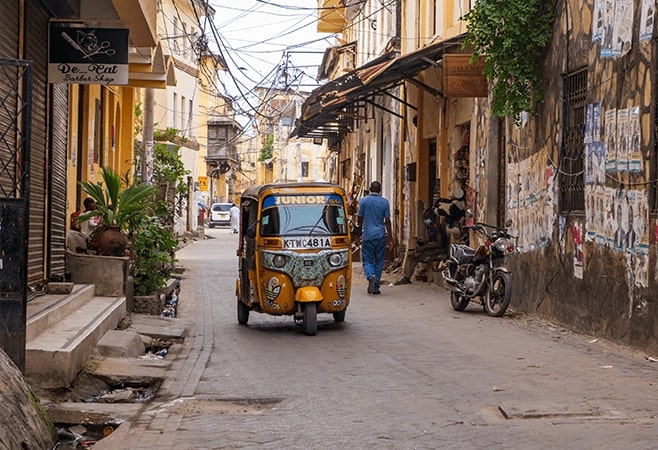
Old Town in Mombasa a historical neighborhood known for narrow streets and diverse culture and for shopping for unique artifacts.
- Where is the Old Town located in Mombasa?
- The Fascinating History of Mombasa’s Old Town: A Crossroads of Cultures
- Best time to visit Old Town, Mombasa
- How to get to Old Town, Mombasa
- Top things to do in Mombasa’s historic Old Town
- Where to stay near the Old Town of Mombasa?
- Before You Go: Must-Know Travel Tips for Mombasa's Old Town
- Conclusion
Where is the Old Town located in Mombasa?
The Old Town of Mombasa occupies the southeastern part of Mombasa Island, which is on the Indian Ocean coast of Kenya. It is next to the world heritage site known as Fort Jesus and extends inland by way of a network of small streets and alleyways. The region is well located near the city center and is among the oldest in Mombasa as it was a a major trading center in the past. Tourists will discover it located near the ancient port where Arab, Persian, Portuguese and Indian merchants moored their vessels many centuries ago. Old Town is still a lively cultural neighborhood today and a destination site to travelers.
The Fascinating History of Mombasa’s Old Town: A Crossroads of Cultures
The history of Mombasa Old Town is deeply rooted in centuries of trade, cultural exchange, and colonial influence along the East African coast. It is located on Mombasa Island, which developed into a flourishing center of merchants of Arabia, Persia, India, and Europe who arrived to exchange spices, textiles, and other precious products. Its strategic location in the Indian Ocean is what made Mombasa a vital hub for trade and cultural interaction and molded the city into a cosmopolitan hub.
The Portuguese constructed Fort Jesus in 1593 to secure their trade routes, but in 1698 the Omani Arabs took control and left lasting Swahili and Islamic influences that still define Old Town’s identity today. This blend of cultures can be traced in the carved wooden doors, narrow alleys and coral stone houses of Old Town.
The coming of the British in the 19th and 20th centuries also contributed to the varied colonial history of the region. While Fort Jesus itself is a UNESCO World Heritage Site, Old Town surrounding it is also recognized for its historical and cultural significance as part of Mombasa’s Swahili heritage. It is still a living museum where there is a merge between the tradition and modern life and it allows the visitor to get a true picture of the past of the Kenyan coast.
Best time to visit Old Town, Mombasa
The best time to visit Old Town in Mombasa is during the dry seasons, from July to October and January to March, when the weather is sunny, warm, and ideal for walking tours. The humidity is also less during these months, and it is easy to wander through the narrow alleyways, old structures, and crowded spice markets without discomfort. The skies tend to be clear and this presents the best photography conditions particularly in and around landmarks such as Fort Jesus and Swahili houses which are beautiful.
However, in case you want to spend less time in the crowd, it is better to visit on weekday mornings when the streets are not so busy and during which you would be able to communicate with local shop owners and guides more easily. Waking up early or taking a walk in the evening is also an ideal way to avoid the midday heat.
The rainy seasons usually occur from April to June and again from October to December, which may make some streets slippery and can render certain streets slippery and not worth exploration. Nevertheless, in case you do not mind taking showers every now and then, this season is a calmer environment with little tourists.
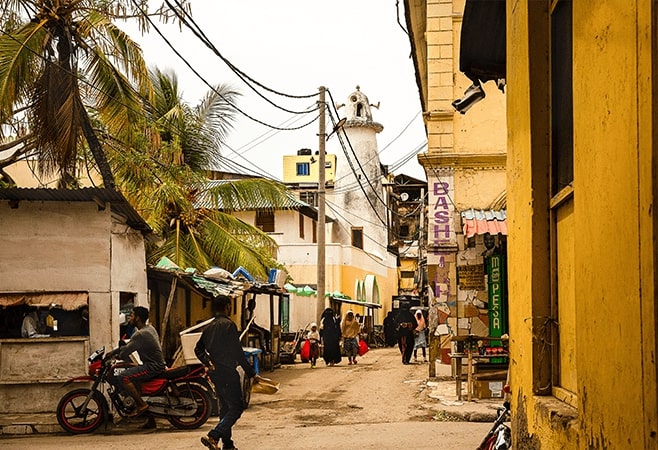
These months are warm and sunny, making it easier to walk through narrow alleys, visit Fort Jesus, and browse the spice markets without worrying about heavy rain.
How to get to Old Town, Mombasa
Old Town in Mombasa is a very interesting heritage site in Kenya that is characterized by centuries-old architecture, Swahili culture and history. Coming to the city to do business, enjoy leisure time, or to have a cultural experience, knowing how to get to Old Town will make your visit smoother and more enjoyable.
By Air
The closest airport is the Moi International Airport (MBA) some 12 kilometers from Old Town. Mombasa has frequent flights to Nairobi and other major Kenyan cities such as Malindi and Diani, with some regional connections available through Nairobi. You can get a taxi, ride-hailing service (such as Uber or Bolt) or hospitality transfer at the airport. It is approximately a 25–30 minute drive based on the traffic.
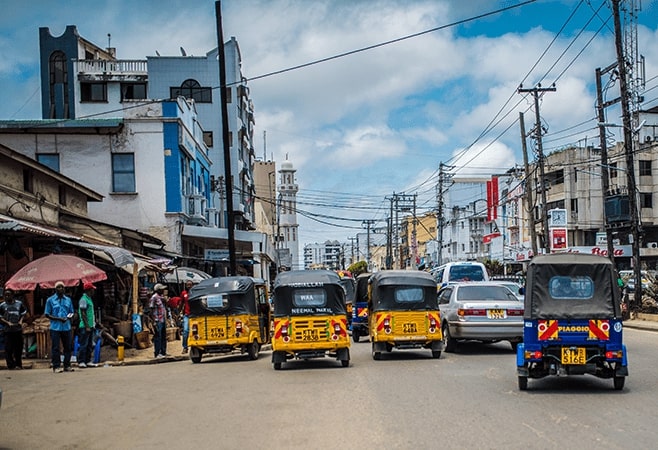
If you are traveling from Nairobi, you can also take the Madaraka Express Standard Gauge Railway (SGR) train to Mombasa Terminus, which is a modern and popular option.
By Train
Mombasa-Nairobi Standard Gauge Railway (SGR) is one of the most popular ways to travel to the city. The train comes to Mombasa Terminus, Miritini, which is about 20 kilometers from Mombasa Island. There, tourists can take a taxi, or use ride-hailing apps to reach Old Town. The trip usually takes 30–45 minutes, depending on the traffic.
By Road
Mombasa is connected with Nairobi and other coastal towns by buses and personal cars. Long distance buses usually drop passengers at central bus terminals in Mombasa, where it takes only a short ride on a tuk-tuk or taxi to Old Town. When self-driving, use the Mombasa-Nairobi Highway (A109) and cross the Makupa Causeway to get to the island.
Local Transport
Once on Mombasa Island, several options are available:
Taxis and ride-hailing apps:
Taxis are a very convenient mode of transportation in Mombasa Island especially for visitors unfamiliar with the area. They are safe, reliable, and easily available at the airport, train station and the hotels. Apps like Uber, Bolt, and Little Cab also are available in Mombasa, so travelers can book a ride at clear prices and track the route on GPS.
This is the best choice for visitors who are first time, family or have luggage, since they will be able to drop-off easily near the main entrances of Old Town. Taxi and ride-hailing cars cost a bit higher than tuk-tuks or matatus, but they are more comfortable, have air-conditioning, and are safe.
Tuk-tuks:
Three-wheeled vehicles known as tuk-tuks are a form of transport that has become a common mode of transport in Mombasa. They are inexpensive, fast and entertaining ways of experiencing local life. The fares are normally negotiable, however, they are affordable when traveling within the island over a short distance. Tuk-tuk can move easily through busy streets but can access only the wider streets near Fort Jesus, but most of Old Town’s inner alleys are pedestrian-only, making walking the best way to explore.
Generally the tuk-tuks will drop you near Fort Jesus and other major access points where you can keep walking around. They are an excellent choice for budget travelers or those seeking to experience the vibrant local atmosphere.
Matatus (shared minibuses):
In Kenya, the main public transport mode is matatus, which also operates in Mombasa. They are the most affordable mode of transport within the city, and the prices are much cheaper than that of cabs or tuk-tuks. Nevertheless, they may be crowded, less comfortable, and may not always be direct. Destinations are labeled on the vehicles, and conductors tend to announce destinations. Although matatus do not necessarily deposit you inside the Old Town, they usually pull up close enough to enable you to walk the remaining distance. They are best suited to adventurous travelers or one who knows how to go by local transport.
Top things to do in Mombasa’s historic Old Town
The Old Town of Mombasa is a living museum of culture, history, and architecture, dating back centuries. Walking through its narrow streets, visitors can experience the blend of Swahili, Arab, Portuguese, and Indian influences that shaped this coastal city. Here are the top things to do in Old Town Mombasa to make your trip unforgettable.
Visit Fort Jesus
One of the most important things to do in Old Town Mombasa is visiting Fort Jesus, a landmark that captures the essence of the city’s long and complex history. Constructed in the 16th century by the Portuguese, this is a huge fortress meant to safeguard their interests in the trade routes along the Indian Ocean.
Today it is a UNESCO World Heritage Site and a living museum that has been telling the story of centuries of cultural exchange and conflict. Fort Jesus has exhibitions of artifacts, weapons, and pottery, as well as historical documents that show how varied the influences of Arabs, Asians, and Europeans. The visitors are also rewarded with panoramic views of the Indian Ocean through its strategic walls, which make it a must-see part of Old Town.
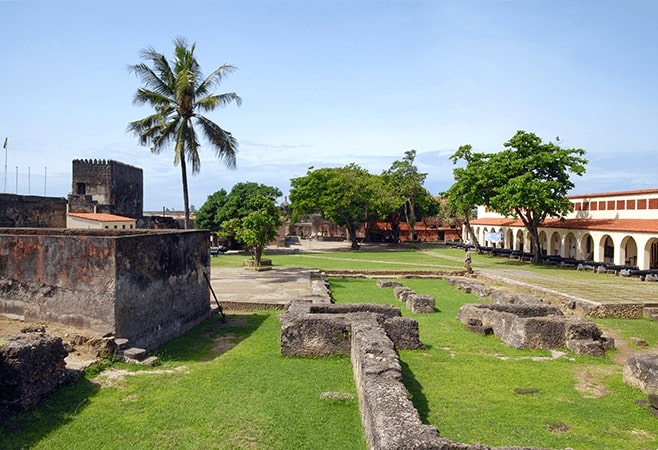
Discover the rich history, architecture, and cultural significance of Fort Jesus in Mombasa
Wander Through the Narrow Streets
Old Town Mombasa is a maze of narrow streets that is a must-see for any visitor. These alleys, which are lined with coral stone houses, elaborate wooden doorways and colorful balconies, reflect the mixture of Swahili, Arab and European influences. When walking, you will come across concealed cafes, antique stores and small mosques between the narrow lanes. Every turn is a surprise and a walk through Old Town itself is a pure cultural experience.
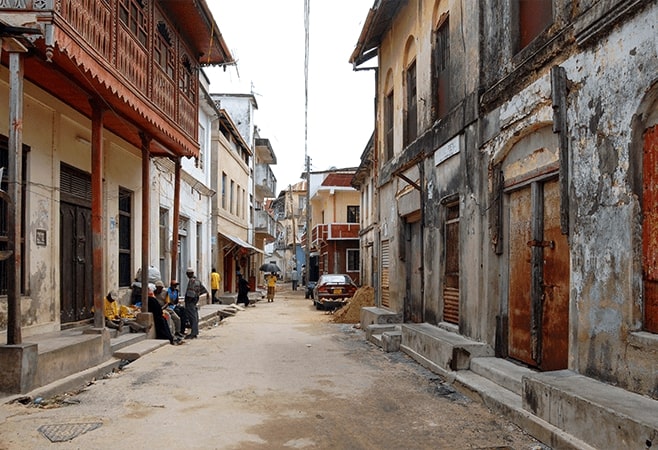
The greatest pleasure of the Old Town is simply getting lost in its maze of streets
Explore the Spice and Curio Markets
Mombasa has long been considered a major center of the spice trade and the vibrant markets of Old Town are the ideal location to explore this heritage. You will also get aromatic spices such as cloves, cardamom, cinnamon, colorful fabrics, handmade jewelry and beautifully crafted souvenirs as you pass by the stalls. It is vibrant and energetic with not only shopping, but also an opportunity to communicate with cheerful locals and know more about Swahili traditions.
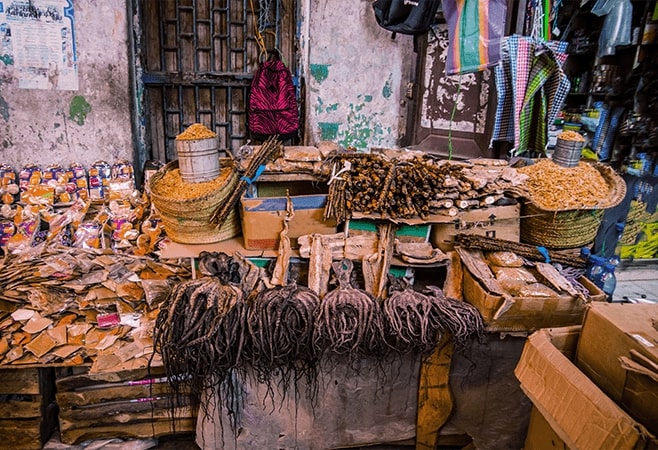
It’s the perfect place to interact with local vendors and practice your bargaining skills
Admire the Architecture
Old Town’s architecture reflects Arab, Asian, Portuguese, and British influences. The combination of designs in the town makes it a living museum, with mosques that have exquisite minarets, Swahili-style houses, and the like. Do not forget to visit the well-known carved doors, which are a typical symbol of the region.
Try Swahili Cuisine
Food is a vital component of the Old Town experience. Local restaurants and street food stalls serve sample dishes such as biryani, pilau, samosas and with dishes such as Swahili biryani, pilau, viazi karai, and coconut-based seafood showcasing the area’s coastal fusion flavors. The Swahili food is a tasty mix of African, Indian and Arabian cuisines.
Join a Guided Walking Tour
Another rewarding way to explore Old Town is by joining a guided walking tour. Although it is fun to spend time walking around on your own, having an experienced local guide helps bring history and culture of the region to life. They share fascinating tales of the historical roads of trade, the coming of the Portuguese, the influence of the Omani and the intertwining of cultures that led to the development of Swahili culture.
You will also hear about the symbolic meaning of carved wooden doors, the architecture and living of the ordinary people in the small alleys. Most tours involve spice markets, mosques and Fort Jesus so you don’t miss the highlights. A walking guided tour will give another dimension of the Old Town adventure; authenticity, personal touch and depth.
Where to stay near the Old Town of Mombasa?
When you are deciding on a location to stay around Old Town Mombasa, you will have direct access to the historical sites, bustling streets, and cultural marvels of the city. Here are some great options:
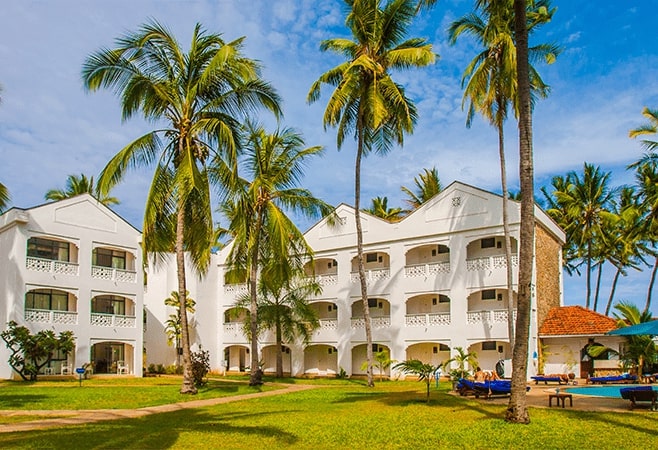
Finding the perfect place to stay near Old Town, Mombasa is key to a memorable trip, offering you easy access to its historical sites while providing modern comfort
1. Boutique Heritage Hotels
Staying in or near Old Town is immensely charming. Find old wooden houses turned into a boutique or guesthouse, some with elaborate wooden doors, traditional interiors and overlooking the old harbor. These put you in the mood of being in the past that you are studying.
2. Mid-Range Hotels in Central Mombasa Island
The central section of Mombasa Island (near Moi Avenue, Nyali Road, or near Fort Jesus) is an area where hotels tend to balance convenience and comfort. Old Town is within easy reach of this, only a short drive or a tuk-tuk ride to get back to it in the evening to do some strolling.
3. Hotels in Nyali and Tudor
For a quieter base, consider the Tudor area by Tudor Creek, or stay in Nyali if you prefer a resort-style experience close to the beach yet within a short drive to Old Town. You can be there at the beach and yet be able to drive to Old Town reasonably. There is also a good road entrance to the old city at Tudor and Tudor Creekside areas where the base is peaceful.
4. Hotels with Historic Views
Old Town also has some hotels where the view is of the old harbor, Fort Jesus, or the coastline. The fact that you wake up to the sound of lapping waves and you have heritage buildings outside your window makes the experience even better.
Tips When Booking:
- Select a service that will pick or drop you at the airport particularly when you are coming late or early.
- As Mombasa traffic can turn short distances into time-consuming ones, confirm proximity (walking distance or short ride in a tuk-tuk) instead of absolute distance in kilometers.
- Enquire about whether the hotel offers a safe parking area, 24 hours check in and 24 hours check out and local guides
Being close to Old Town enables you to experience its history and culture, without having to commute long distances, and thus, days and nights in Mombasa are part of travelling itself.
Before You Go: Must-Know Travel Tips for Mombasa's Old Town
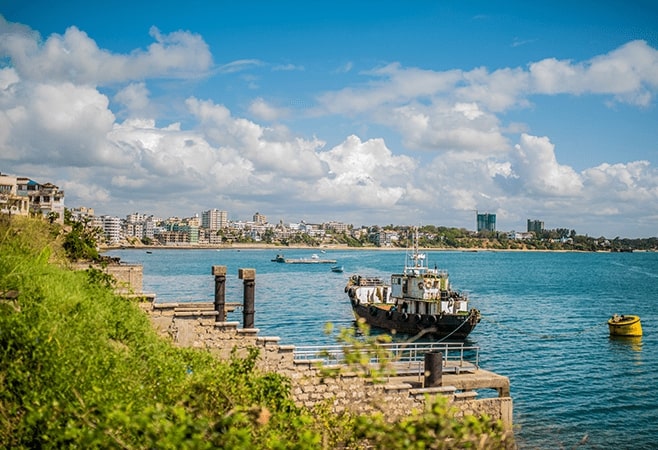
Commune with nature and explore the great outdoors at Mombasa Island during your travels in Mombasa
Here is a guide with essential tips to make your visit to Mombasa's historic Old Town enjoyable and safe:
Cultural Etiquette & Dress
- Dress Respectfully: Old Town is a predominantly Muslim area. In order to respect the local culture, it would be better to dress in such a way that your shoulders and knees will not be visible. This is especially necessary when you intend to visit any of the ancient mosques, even when you are just looking outside.
- Ask Before Photographing: Use courtesy and seek permission before capturing shots of the locals, business owners or their children. Even a polite gesture goes a long way
Practical & Safety Advice
- Lock up Your Valuables: Like any crowded tourist site, keep your eyes open. Keep your wallet and phone locked, and do not wave diamond rings or cameras to discourage petty theft.
- Bring Small Cash: There are lots of small vendors, spice dealers, and Tuk-Tuk drivers who do not take the credit. Carry sufficient Kenyan Shillings (KES) in small bills to use in buying, serving tips and transport.
- Negotiate Nicely: There is no reason to be rude in the markets but be friendly and nice. Begin low, but do not unfairly exploit the local craftsmen and merchants.
- Keep hydrated: Mombasa is a hot and humid place, particularly when one is walking through the maze-like streets. Always have a bottle of water by you to keep you hydrated on your adventure.
- Hire a Local Guide: To best explore the history and culture, it might be worth hiring a local guide, or visiting a Mombasa Old Town tour. Guides give more in-depth knowledge of the Swahili history of the area, colonial history, and secret spots that you would not have learned without the guides.
- Transportation Hints: It is possible to reach Old Town by Tuk-tuk- a fun and cheap method of transportation. There is also a lack of parking space, hence it is advisable not to drive yourself. Longer distances can also be done by taxi and ride-hailing app.
Bring the Right Travel Documents
Foreign travelers should always carry valid travel documents. A passport is required for hotel check-ins, and most visitors will need a Kenya ETA (Electronic Travel Authorization), which must be obtained online before arrival. Keep both printed and digital copies of your ETA and passport. Some hotels may also request additional details, such as proof of onward travel. Having these documents readily available ensures smooth entry, check-in, and compliance with local regulations.
Conclusion
Old Town Mombasa is much more than a group of ancient buildings, and it is a living museum that narrates the lively tale of the Swahili Coast. You will unlock the very secrets of this historical hub by simply opting to appreciate its small streets by foot and taking a respectful glance at the rich cultural heritage. Don’t forget to give Fort Jesus time, mingle with the hospitable local people and enjoy the native Swahili food.
The Old Town is an unedited glimpse into centuries of trade and tradition, with its ornate carved doors, the aroma of spices and the busy life in the port. Embrace the hustle and bustle, take our advice and your visit to the Old Town of Mombasa will be a rewarding adventure that will not be forgotten easily.
Related Articles
- The Ultimate Tea Explorer: Discover the 11 best places to visit in Limuru a Quiet Weekend Escape
- From Peaks to Plains: Exploring the 11 Best Places to visit in Kitale for Your Bucket List
- From Luxury to Comfort: A Guide to the Top 14 Hotels in Nakuru for Unforgettable Memories
- A Guide to the Best Cafés and Coffee Shops in Momba for Quality Brews and Unbeatable Vibes
- Dancing Until Dawn: Discovering the Ultimate Nightlife in Mombasa, Kenya
- The Hidden Gem of Kenya: An Essential Travel Guide to Laikipia County
- Journey to the Rift Valley: The Ultimate Lake Elmenteita Travel Guide for Adventurers
- The 14 Best Cafes and Coffee Shops in Nairobi for Fresh Brews and Tasty Meals











